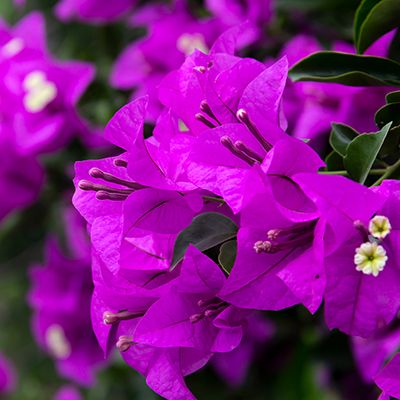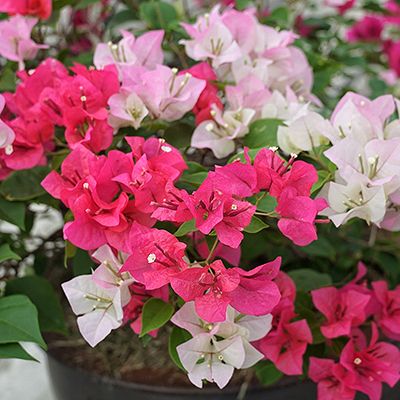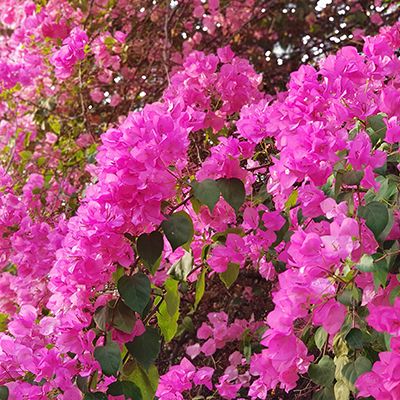


Bougainvillea
Boo-guhn-vil-ee-uh
Bougainvillea are native to Brazil and other tropical and subtropical parts of South America. Despite this heritage, they grow quite well in most parts of the Bay Area and will thrive when planted against a warm (south or west facing) wall. To bloom well, they need full all day sun. With afternoon shade or dappled sun, they will produce abundant dark green leaves but few flowers.
Consider the Bougainvillea to be a vine. Those most commonly admired will have main branches from 10 to 25 feet long and be six to eight feet wide. The branches are armed with three to four inch long, needle-like, hard, sharply pointed thorns. The novice or careless gardener can suffer unpleasant punctures while pruning or working with Bougainvillea. The vines cannot support themselves and must be (carefully) tied in place until the basic structure is established. The vines are not “well behaved” and though tied in place will sprout long branches growing in all directions and at 90° angles to the main plant. These should be cut off where they join the main stem.
Bougainvilleas should be pruned in spring at which time they are also shaped to order. They bloom on new wood so pruning should be done to encourage this new growth. The blooms on bougainvilleas are actually modified leaves called bracts. Within each bract cluster is a tiny, inconspicuous, tubular, true flower. Bracts may be orange, scarlet, white, pink, purple, gold, rose or lavender and produce the massive colorful display so much admired.
Bougainvilleas are not fussy about their soil, so long as it is well drained. The planting area of our heavy clay soil should be amended with one-third compost such as Master Nursery® Gold Rush or a similar product before planting the new vine. The roots of these vines do not hold the soil together in a firm root ball and they are very sensitive to disturbances. To minimize shock when planting, cut off the container bottom and set the container with its vine in the planting hole. Slide the container up over the plant, filling in with the soil-compost mix as you go. Firm the mix around the root ball and add water until it stops bubbling. Repeat the watering after one-half hour and once each week for the first year. Use excess soil to make a berm at the perimeter of the hole to retain water. As the plant matures, irrigate enough to keep the soil moist down to the 12 to 18 inch level. When the plants become well established, they are moderately drought tolerant.
Fertilize Bougainvillea lightly, twice a year, about Valentine’s Day and the Fourth of July, using Master Nursery® Formula 49™ or Citrus Food. Spread the fertilizer at or just beyond the drip line of the vine’s main body. Water thoroughly.
There are as many different forms and shapes of Bougainvillea as there are colors. Some are only 18” high and can be used as ground cover or for containers. Others can be trained to tree form or espaliered on a fence.
Bougainvilleas are practically disease free; just don’t let them sit in water. Mildew has been reported on one plant growing in the shade. Spray three to four times one week apart with sulfur (Safer® Garden Fungicide). Insects are not a problem. Birds and other predators seem to pick off any stray bugs which appear on the plants.
A hard frost (25°F or less) will damage any leaves left on the vines. Severe frost may top kill a plant but leave it alone. Do not trim or give up on it until the following June. Since Bougainvillea are grown from tip cuttings (quite easily), they often re-emerge from the root. At that time, you can cut away all of the dead material and watch the new plant develop.
All of the Bougainvilleas do not perform equally well in the Bay Area. The following are observations of one or two varieties of four colors of Bougainvillea bracts: The more light colored the bracts, the greater the need for a mild climate to produce maximum bloom. For example, “California Gold” (yellow), blooms well in the San Diego area but not in the Bay Area. It does not take frost well.
“Barbara Karst” and “San Diego Red” are two of the best Bougainvillea for the Bay Area. Both are vigorous growers, bloom young and come back fast after a frost. They have deep red bracts that appear over a long season. Their deep green leaves hold on well in cold winters.
“Texas Dawn” is pink. It grows fairly well in most of the Bay Area but the color lacks the excitement of darker varieties.
B. brasiliensis “Purple Queen” is a large, vigorous vine with huge clusters of purple bracts. It blooms well in cool summers and recovers quickly after hard frosts.